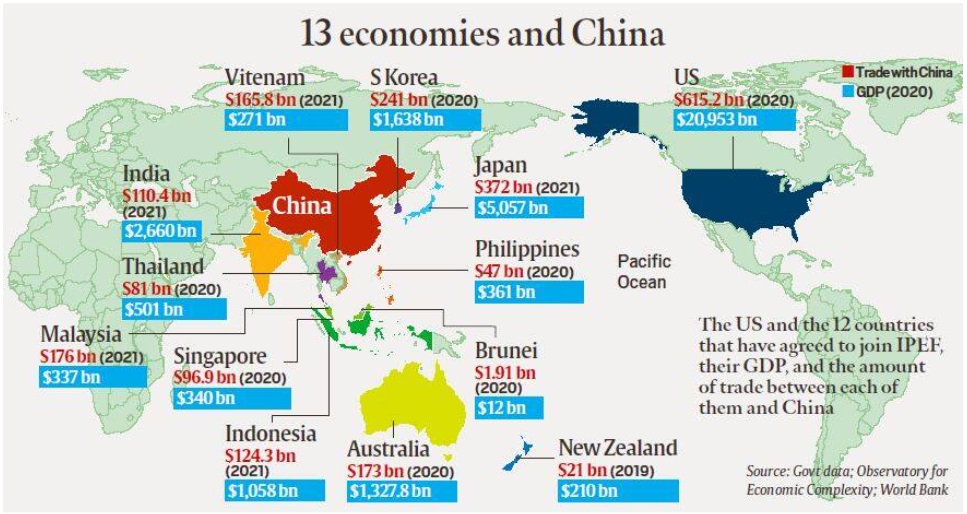Friday, 27th May 2022
Sugar export curbs and their impact
In News: The government has recently decided to “restrict” the export of sugar, effective from June 1, 2022.
About the News:
- The curbs, the first such move in four years, have been ordered to maintain domestic availability and price stability of sugar.
- India is the biggest producer of sugar and the second largest exporter after Brazil and hence these curbs will have a significant impact on both the domestic and the international markets.
The latest curbs:
- The government has moved export of sugar from the ‘open category’, which requires no government intervention, to ‘restricted’ category.
- This means that export of sugar is allowed only with specific permission from the Directorate of Sugar, Department of Food and Public Distribution (DFPD), Ministry of Consumer Affairs, Food & Public Distribution.
- The curbs will come into effect from June 1 and will continue till October 31, or until further orders.
- Therefore, unlike wheat, where export has been banned, sugar would continue to be exported, but from June 1, permission would be required to send the shipments out.
India’s sugar export during the last few seasons:
- The exports of sugar has boomed over the last few years with the Centre also extending subsidies to millers to push sales abroad.
-
- In 2017-18, the government set a target to export 20 lakh tonnes of sugar of which the industry recorded exports of 6.2 lakh tonnes.
- In 2018-19, 50 lakh tonnes export target was set of which 38 lakh tonnes of sugar was shipped out.
- After a bumper crop in 2019-20, export quota was hiked to 60 lakh tonnes with an increased subsidy.
- The traction in the international market helped sugar exports touch 70 lakh tonnes in 2020-21, out of which 60 lakh tonnes was done using government subsidy and 10 lakh tonnes was exported without any government aid.
- The export without government subsidy was done under the open general license regime.

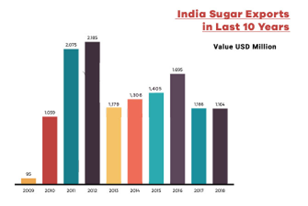
- What also helped exports grow over the last few seasons is the fact that Brazil produced more ethanol than sugar due to the exceptional rise in fuel prices.
- Added to this, is drought hitting other big sugar producers like Thailand that helped India venture in countries which otherwise were dependent on Brazilian sugar.
Need for the curb:
- Exports can continue unabated due to international demand but a possible worry is low stocks at the beginning of the next season which can lead to supply constraints for around three months.
- The sugar season officially starts in October, but picks up momentum only after December. If there is scarcity of back-up stocks during this period then prices can escalate in the domestic market which the government cannot afford.
- The present curbs would ensure the government keeps a tab on sugar stock real-time to ensure that there is no shortage at the start of the next season.
Source:
- Explained: Sugar export curbs and their impact
- India Curbs Sugar Exports from Next Month: What it Means, How it will Control Sugar Prices
Image source:
National Mobile Monitoring System
In News: The Union government has made capturing of attendance through its app, National Mobile Monitoring System, compulsory at worksites where 20 or more workers under the Mahatma Gandhi National Rural Employment Guarantee Scheme (MGNREGS) are employed.
About the News:
- National Mobile Monitoring Software (NMMS) App was launched by the Minister of Rural Development on May, 21 2021.
- Initially, the utilisation of application was to be voluntary, it has been made mandatory.
- The National Mobile Monitoring Software (NMMS) App permits taking real time attendance of workers at Mahatma Gandhi NREGA worksites along with geo-tagged photograph.

- The App is applicable for the Mahatma Gandhi NREGA workers for all the States/ Union Territories.
Benefits of NMMS App:
- This app is aimed at bringing more transparency and ensure proper monitoring of the schemes.
- The app helps in increasing citizen oversight of the programme.
Problems with NMMS App:
- Patchy Internet connectivity in rural areas: Despite major telecom companies catering to the remote areas of India, internet connectivity remains an issue in hilly areas and remote villages.
- The supervisors of the worksites are expected to have a smartphone with Internet connection. According to officials from various States, there have been complaints from the mates that they are not given added incentives to pay for the smartphones or Internet connections.
- Little or no technical support: People at the village level and even at the block level struggle to understand everything the app has to offer. So the workers have to suffer.
- The speed of the application and the strength of the server: The upload of documents is slowed down due to the speed of the application and the strength of the server and the workers get anxious as the attendance directly affects their pay.
Sources:
Sex workers right to dignity
In News
- Supreme court gives legal recognition to sex work as profession
About the News
- A three-judge bench led by Justice L. Nageswara Rao has recently passed an order recognising sex work as a “profession” whose workers are entitled to dignity and equal protection under law.
- The honourable court has invoked the extraordinary power conferred on it under Article 142 of the Constitution to do complete justice in any case.
- Recognising sex workers right to a dignified life under Article 21 of the Constitution, the court has directed those police should neither interfere nor take criminal action against adult and consenting sex workers.
- The court has also directed that sex workers who are victims of sexual assault should be provided every facility including immediate medico-legal care etc.,
- Previously, in 2011 the Supreme court had constituted a panel under chairmanship of Pradip Ghosh in 2011 to recommend steps to improve plights of sex workers in the country.
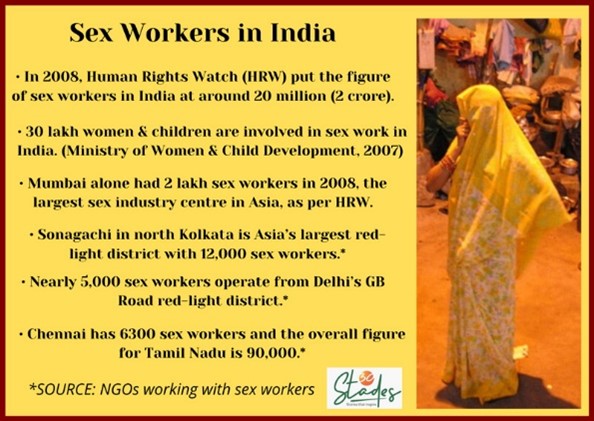
What are the major highlights of the judgement?
- Right to dignity: Notwithstanding the profession, every individual in this the country has a right to a dignified life under Article 21 of the Constitution of India and so sex workers should not be arrested or penalised or harassed or victimised as voluntary sex work is "not illegal" and only running the brothel is unlawful.
- Legal recognition in law: when a sex worker makes a complaint of criminal/sexual/any other type of offence, the police must take it seriously and act in accordance with the law.
- Protection against harassment: Whenever there is a raid on any brothel since voluntary sex work is not illegal and only running the brothel is unlawful, the sex workers concerned should not be arrested or penalised or harassed or victimised."
- Protection to offspring: Basic protection of human decency and dignity will also be extended to sex workers and their children.
- Media to act responsible: The SC bench has said the media should take utmost care not to divulge the names of sex workers, whether as victims or accused, during arrest, and rescue operations, and not print or broadcast any images that may result in revealing identities.
- Correction homes: The bench recommended that sex workers be sent to 'correction homes' for at least two to three years and if the magistrate decides that the sex worker had consented, they could be let out.
- Use of condom is no evidence of crime: The SC has stated that police shouldn't interpret the use of condoms by sex workers as proof of criminal activity.
- Decree under article 142: The court has directed State Governments and Union Territories to act in strict compliance with the recommendations made by the panel and agreed upon by the Centre. Besides, it has also directed the competent authorities under the Immoral Traffic (Prevention) Act, 1956 are directed to comply with the provisions of the Act.
- Direction to UIDAI: The court also directed that Aadhar Cards shall be issued to sex workers on the basis of a proforma certificate which is issued by UIDAI and submitted by the Gazetted Officer at NACO or the Project Director of the State Aids Control Society, along with the Aadhar enrolment form/application.
Sources:
- Recognising sex work as work:
- https://www.ndtv.com/india-news/voluntary-sex-work-is-not-illegal-recommends-supreme-court-panel-3012936
Image:
Founding of St. Petersburg
On May 27, 1703, the city of St. Petersburg was founded by Peter the Great. St. Petersburg has played a vital role in Russian history and is especially known as the scene of the 1917 revolutions and as a fiercely defended city during World War II. St. Petersburg, Russian Sankt-Peterburg, formerly (1914–24) Petrograd and (1924–91) Leningrad, city and port, extreme northwestern Russia. It is the second largest city of Russia and one of the world’s major cities. Architecturally, it ranks as one of the most splendid and congenial cities of Europe.

Its historic district was designated a UNESCO World Heritage site in 1990. the bridges and natural canals of the river have earned St. Petersburg the nickname “Venice of the North.” Because of St. Petersburg’s northerly location, the city enjoys the “White Nights,” from June 11 to July 2, when daylight extends to nearly 19 hours—another of St. Petersburg’s most acclaimed characteristics.
On this day, death anniversary of Jawaharlal Nehru: https://edukemy.com/current-affairs/gazette/2021-05-27/this-day-in-history-pandit-jawaharlal-nehru
Source:
Committee report on MSMEs
In News
The Standing Committee on Finance has recently presented its report on ‘Strengthening Credit Flows to the MSME Sector’.
What are the major highlights of the report?
- Bridging credit gap by forming a digital ecosystem:
- Digital inclusion: It took note of the launch of the Udyam registration portal by the MSME Ministry and the success of public digital infrastructure projects such as BHIM UPI and Aadhaar.
- Data repository: The Committee noted that the Udyam portal can act as a central data repository by lenders to extend timely credit.
- Adopting an account aggregator framework:
- Safety valve: An account aggregator framework can benefit the sector by improving access to credit, preventing fraud, and reducing non-performing assets.
- More security: The framework allows secure sharing of digital financial data. The Committee noted the pilot success of SAHAY platform which enables instant digital lending to MSMEs and replaces physical collateral with secure access to GST invoices.
- Poor credit dispersal: The Committee noted that less than 40% of MSMEs avail credit from formal financial systems and therefore depend on costly and unreliable credit.
What are the major recommendations?
- Digital ecosystem: The committee has recommended creating a digital ecosystem for lending to MSMEs in order to solve problems such as physical collateral requirements, lengthy verification processes, and paper-based loan applications.
- Cash-flow lending: The lending to the MSME sector be move to cash-flow based lending which will replace lending based on physical asset as collateral, with information-based system.
- Streamlining: Working capital to MSMEs to be provided on the basis of GST invoices in order to spur formalisation, including the GST registration of businesses.
- Providing targeted credit guarantees: The Committee noted that weaker borrowers require higher support during situations of emergency and thus it recommended targeting specific industries such as salons and tour agencies, and specific geographical areas to provide government guarantee programs.
- Support to SIDBI: Strengthening SIDBI’s equity base by injecting equity between Rs 5,000 crore and Rs 10,000 crore, and building up its organisational capabilities to provide financing to the NBFC sector and lower borrowing rates.
- Nodal agency: It recommended making SIDBI the nodal agency for Udyam value-added financial applications since it has a loan portfolio of nearly Rs 1.6 lakh crore in 2021-22 with the MSME sector contributing 30% to the GDP.
- Vyapar Credit Card scheme: Launching a Vyapar credit card scheme along the lines of the Kisan Credit Card scheme which can provide its holders short term loans at low interest rates for meeting working capital requirements.
What are the Challenges faced by the MSME sector?
- Poor financial support: Lack of strong financial stimulus with concessional working capital loans from the government and financial institutes results in inadequate liquidity in business operations of MSMEs.
- Very few registrations: Most of the MSMEs are not registered anywhere mainly because of their small size. This apparent invisibility works against them in a time of crisis as it constrains a government’s ability to help them through wage subsidy or extra credit.
- Lack of formal banking support: According to a report by the International Finance Corporation (part of the World Bank), the formal banking system supplies less than one-third (or about Rs 11 lakh crore) of the credit MSME credit need that it can potentially fund.
- Bad loans: A key reason why banks dither from extending loans to MSMEs is the high ratio of bad loans with higher slippage for relatively bigger enterprises.
- Delays in payments: The other big issue plaguing the sector is the delays in payments to MSMEs — be it from their buyers (which includes the government also) or things like GST refunds etc.
- Impact of Covid-19: MSMEs were already struggling — in terms of declining revenues and capacity utilisation — in the lead-up to the Covid-19 crisis with most firms not having too much cash to wait out the crisis.
Government efforts for MSME
- Credit linked subsidy: The government launched the Special Credit Linked Capital Subsidy Scheme (SCLCSS) in 2021 for the services sector to help meet various technology requirements.
- SAMBHAV: Ministry of Micro, Small and Medium Enterprises launched SAMBHAV in 2021 which is a national-level awareness programme to push economic growth by promoting entrepreneurship and domestic manufacturing.
- India export initiative: Ministry of MSME has launched ‘India Export Initiative’ and ‘IndiaXports 2021 Portal’ to help exports reach its Rs. 2,928,000 crore (US$ 400 billion) target by the end of FY22 and further push it to Rs. 7,320,000 crore (US$ 1 trillion) by FY27.
- Support from Khadi: Khadi and Village Industries Commission (KVIC) has established the first ‘Silk Yarn Production Centre’ in Odisha to boost the local silk industry and generate employment. It has also launched SPIN (Strengthening the Potential of India) scheme and built a pottery cluster under SFURTI Scheme in Varanasi to support >1,100 individuals of the marginalised potters’
- Budgetary support: Budget allocation for MSMEs in FY22 is more than doubled to 15,700 crore (US$ 2.14 billion) vis-à-vis Rs. 7,572 crore (US$ 1.03 billion) in FY21.
- Loans: The government also announced Rs. 3 lakh crore (US$ 40.85 billion) collateral-free automatic loans for businesses.
- Emergency credit supports: The government has established funds worth Rs. 10,000 crore (US$ 1.36 billion) for ‘Guarantee Emergency Credit Line’ (GECL) facility to eligible MSME borrowers, giving a major boost to the sector.
What more can be done?
- Tax relief: The government can provide tax relief (GST and corporate tax), give swifter refunds, and provide liquidity to rural India for example, through PM-Kisan to boost demand for MSME products.
- Priority lending supports: Pumping of institutional money from RBI mandates under priority sector lending scheme.
- Credit guarantees: A credit guarantee by the government can help assure the bank that its loan will be repaid by the government in case the MSME falters.
Conclusion: With the government of India’s vision of doubling the Indian economy to US$ 5 trillion in five years, there is need to create opportunities for the young population and MSMEs have the potential to serve as a key employment generator.
In order to achieve these targets, the government should invest in providing more back-end services to improve performance of the MSME sector as it supplies goods and services to big industrial enterprises. Lack of technology-based production activities and low investment in R&D activities are bottlenecks hindering the sector to become competent. Globally available technology could be subsidised by the government so that the product quality of MSME players can be improved using the existing resources. This also requires the help of academic institutions in the form of providing research and development (R&D) services for product innovation.
Source:
Flamingos in Mumbai
This is image of colonies of Flamingos in Navi Mumbai. The Mumbai Metropolitan Region (MMR) has recorded the highest number of greater flamingos in 2021-22. This is the highest since 2018, when the Bombay Natural History Society (BNHS) annual flamingo monitoring exercise began.
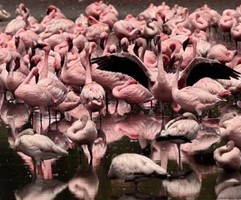
Flamingo is a type of wading bird in the family Phoenicopteridae. They are famous for their bright pink feathers, stilt-like legs, and S-shaped neck. They are able to "run" on water, thanks to their webbed feet, to gain speed before lifting up into the sky. Most flamingo species are not endangered, although the Andean flamingo is listed as vulnerable, and the Chilean, Lesser, and Puna flamingos are near threatened, according to National Geographic. Light pollution is a significant and growing threat to wildlife including many species of migratory birds such as flamingos.
Source:
Long COVID
- Context: Studies have found that Women may be disproportionately affected by Long COVID.
- Some people who have been infected with the COVID-19 virus can experience long-term effects from their infection, known as post-COVID conditions (PCC) or Long COVID also referred to as long-haul COVID, post-acute COVID-19, etc.

- The condition occurs in individuals with a history of probable or confirmed SARS CoV-2 infection, usually 3 months from the onset of COVID-19 with symptoms and that last for at least 2 months.
- Common symptoms include fatigue, shortness of breath, an erratic heart rate, headaches, dizziness, depression and problems with memory and concentration.
- Experts theorize that an immune response that goes into overdrive, when one first gets sick which may lead to inflammation and damage throughout the body, eventually resulting in long COVID symptoms.
- People at Risk are those with Pre-existing medical conditions, people between the ages of 36 and 64.
- Getting a COVID vaccine can reduce, but not eliminate the risk of longer-term symptoms.
Source:
- A clinical case definition of post COVID-19 condition by a Delphi consensus, 6 October 2021
- What we know about long Covid so far
Image source:
Sinkholes
- Context: A primitive forest, at the bottom of a giant sinkhole has been discovered in China recently.
- Sinkholes are depressions formed in the ground when layers of the Earth’s surface start collapsing into caverns.

- Usually, they form in areas of “karst” terrains and they sometimes form gradually over time or suddenly without warning.
- Sinkholes vary in size but can range anywhere from 3.3 to 980 feet (1 to 300 meters) in diameter and depth.
- The main causes of sinkholes are weathering and erosion.
- This happens through the gradual dissolving and removal of water absorbing rock like limestone as percolating water from the Earth's surface moves through it.
- As the rock is removed, caves and open spaces develop underground.
- Once these open spaces become too large to support the weight of the land above them, the surface soil collapses, creating a sinkhole.
- Also, they happen from human activity, due to broken land drains, water mains, sewerage pipes etc.
- Sinkholes are used as disposal sites for various forms of waste. Tourism and cave diving is popular in many of the world's largest sinkholes.
Source:
- Explained: Discovery of a primitive forest at the bottom of a giant sinkhole in China
- Geography of Sinkholes
Image source:
Terminator tank support system
- Context: Russia has deployed the Terminator tank support system in an area that remains its immediate tactical priority in the Ukraine war.
- Also known as the BMPT ‘Terminator’, the Boyevaya Mashina Podderzhki Tankov (BMPT), is a tank support fighting vehicle developed by Russia.
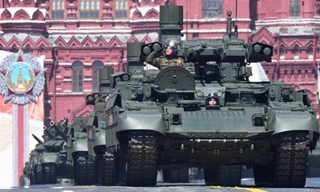
- The tank support vehicles are designed to protect the Russian tanks against enemy infantry.
- They are basically a replacement for mechanised infantry troops in the urban battlefield.
- The weapons on Terminator, are capable of firing in multiple directions in quick succession, thus suppressing firepower to prevent any attempt to take out the tank columns being protected.
- Guerrilla warfare tactics used by the Chechen fighters in Grozny during the First Chechen War in 1995, led to the development of this weapon system as many Russian tanks were lost in the urban fighting.
Source:
- DNA Explainer: How Russia's Terminator tank support system can be a game changer in Ukraine war
- Explained: What is Russia’s Terminator tank support system, now deployed in Ukraine?
Image source:
Art and Architecture of the Cholas
- Context: The Grand Anicut or Kallanai built by Karikala Chola between 100 BCE and 100 CE in Thanjavur District, was recently recognised as a World Heritage Irrigation Structure.
- The Chola art and architecture had the influence of the Pallavas, and other contemporary art and architecture schools, which in turn helped them to elevate the Dravidian form to greater heights.
- The Brihaddeshwara Temple at Tanjore, built by Rajaraja the Great, is the most magnificent example of the Chola architecture.
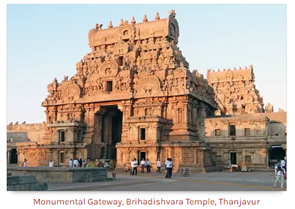
- Temple by Rajaraja’s son and successor Rajendra I in his new capital, Gangai-Konda Cholapuram, is known for its great size huge ‘lingam” of solid granite and delicate carvings in stone.
- The third of the great royal Chola temples dedicated to Shiva, the Airavatesvara, was completed by Rajendra Chola II in 1167 at Darasuram.
- With respect to Chola sculptures, Chola bronzes were made using the lost-wax casting technique.
- Shiva in Nataraja, Tripuraavijaya, Chandrashekhara are the most prominent ones of this form.
- The beautiful portraits on the walls of the Koranganatha and Nageswarasamy temples exhibit the artistry of the craftsmen during Chola time.
- The Cholas also contributed to the growth of both vocal and instrumental music. Instruments such as kudamula, veena, and flute were used.
- The classical dance forms of Bharatnatyam and Kathakali acquired its basis from under Chola patronage.
Source:
Image source:
On gun control, children paying the price of inaction- Indian Express
Essence: The editorial highlights the plight of parents and general public who fall victim to gun violence in America and actions that are mandated to be taken to reform such a rampant culture. The children and parents do not share the space of cheer, fun and fearfulness as they part ways at school bus or school gates. There is a fear of mass shooting/active shooter incidences at school areas.
To take preventive steps, the schools and districts have taken steps like lockdown drill, emergency protocol measures, video surveillance, single points of entry, distress buttons, etc. but the larger question prevails- why shouldn’t there be a strict regulation on gun ownership in the country which has more guns than the total population.
It is due to the gun lobby groups who have rallied behind the Republican party and quotes the 2nd Amendment to US Constitution. The amendment mandates the right to bear arms. People relate it with their personal liberty and self-defense. There is a conversation that restricting the rights of law-abiding citizens won’t prevent crime but going after felons would do. Armed law enforcement on campus is being suggested. This is the result of lobby groups (read National Rifle Association) and inaction of the government. The author is disturbed with the reality that children and their parents shouldn’t bear the price of inaction of government.
Why you should read this article?
- To know the cause and consequence of firearms ownership in USA.
- To understand the logic given by people who defend right to firearm ownership.
Source:
Sighting the finish line in measles rubella elimination- The Hindu
Essence: The editorial discusses the Measles Rubella vaccination program in small children and the need for war footing efforts to eliminate both the viral disease in children. The government had planned to eliminate MR from India by 2020, through vaccine-induced immunity. To cover the immunity gaps, a second dose was mandatory. Schools were chosen as the epicenter to deliver the vaccination for the convenience of all. But due to Covid pandemic, the program got delayed.
Now, government has reset the target of MR elimination by 2023, with zero transmission, evidenced by zero clinical disease, sustained over 3 years- through vaccination and surveillance.
Measles outbreak has higher mortality amongst children. And rubella transmission from mother to foetus could lead to severe birth defects in the newborn. Since, the program of school vaccination doesn’t create any vaccination side-effects, timely inoculation is necessary with the help of district administration.
Why you should read this article?
- To know about the MR program of India and why it deserves special attention.
Source:
Making sense of the GST bonanza- Indian Express
Essence: GST collection has shown significant increase in recent months. Now the question keeping policy makers awake is: Whether the GST level will stabilize at a higher level or not.
This increase in collection of GST is because of rise in inflation, higher imports, formalization of economy, increase in compliance and checking practice of fake invoicing. But authors have pointed out that even after adjusting for inflation and import push, growth in GST has remained above GDP growth showing a salutary effect of increased tax buoyancy.
Now to maintain this growth rate, authorities will have to further push up compliance levels particularly among industries who sources inputs from the informal sector. Reducing the number of goods and services in the exemptions list will also help.
Tax rate increase is inevitable if GST collection has to be on the growth highway. There is no case to increase taxes under the current economic downturn. However, as soon as the situation improves governments will have to bite this bullet of rate hike.
Why should you read this article?
- To understand factors contributing to the recent increase in GST collection.
- To understand what steps governments should take to keep the momentum of GST collection high.
Source:
Eco Warrior of Odisha’s Astaranga Beach
Background
Rahul Maharana of Odisha spends his Sunday mornings collecting waste from the Devi estuary near Astaranga beach and the adjoining mangrove plantation in order to contribute to the fight against climate change.

About Rahul’s Journey
- Rahul Maharana, a security guard for a private enterprise in Odisha, was in Class 12 when he first learnt about climate change and the catastrophic impacts of plastic waste on the earth.
- Rahul decided to delve into the cause and began collecting waste from locations such as the Olive Ridley turtle nesting sites in Rushikulya, Pir Jahania beach, and others, accumulating 500 bags of waste.
- He opted to focus his clean-up efforts on Astaranga Beach, which also has the district's sole mangrove plantation. He has now recovered nearly a tonne of plastic waste on his own.
- He has spent every Sunday morning since January 2022 marching towards a solitary mission carrying a jute sack and collecting all forms of litter scattered in the vicinity.
Quote: “It cannot be right to manufacture billions of objects that are used for a matter of minutes, and then are with us for centuries.”– Roz Savage
Source:
Share the article
Get Latest Updates on Offers, Event dates, and free Mentorship sessions.

Get in touch with our Expert Academic Counsellors 👋
FAQs
UPSC Daily Current Affairs focuses on learning current events on a daily basis. An aspirant needs to study regular and updated information about current events, news, and relevant topics that are important for UPSC aspirants. It covers national and international affairs, government policies, socio-economic issues, science and technology advancements, and more.
UPSC Daily Current Affairs provides aspirants with a concise and comprehensive overview of the latest happenings and developments across various fields. It helps aspirants stay updated with current affairs and provides them with valuable insights and analysis, which are essential for answering questions in the UPSC examinations. It enhances their knowledge, analytical skills, and ability to connect current affairs with the UPSC syllabus.
UPSC Daily Current Affairs covers a wide range of topics, including politics, economics, science and technology, environment, social issues, governance, international relations, and more. It offers news summaries, in-depth analyses, editorials, opinion pieces, and relevant study materials. It also provides practice questions and quizzes to help aspirants test their understanding of current affairs.
Edukemy's UPSC Daily Current Affairs can be accessed through:
- UPSC Daily Current Affairs can be accessed through Current Affairs tab at the top of the Main Page of Edukemy.
- Edukemy Mobile app: The Daily Current Affairs can also be access through Edukemy Mobile App.
- Social media: Follow Edukemy’s official social media accounts or pages that provide UPSC Daily Current Affairs updates, including Facebook, Twitter, or Telegram channels.


